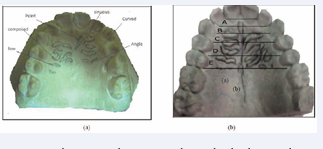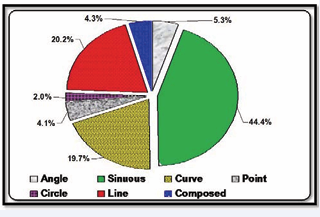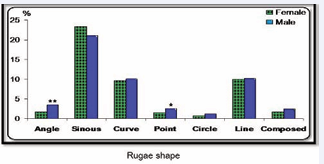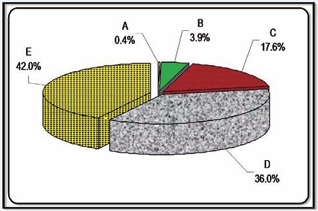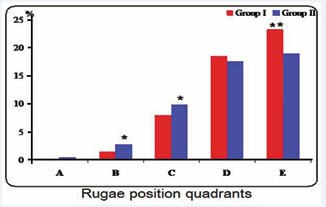Palatal Rugae Biometric Characteristics for Use in Human Identification in an Upper Egyptian Population Sample
- 1. Forensic Medicine and Clinical Toxicology department, Assiut University, Egypt
- 2. Forensic Medicine and Clinical toxicology department, Al Azhar University, Egypt
- 3. Fixed Prosthodontics, Assiut University, Egypt
Abstract
Palatal rugae may be an alternative identification mode when it is difficult to utilize fingerprints or dental records. The present study was undertaken to estimate palatal rugae biometric characteristics of a population sample from Upper Egypt; and to compare age and gender effects on rugae pattern. The study sample comprised 100 dental casts of volunteers or patients attending Al-Azhar Dental Hospital (Assiut branch), 25 males and 25 females with age range 20-30 years (group I) and another set with age range 40-50 years (group II). Trobo’s classification was implemented. Results revealed that sinuous rugae shape was the most prevalent in the total sample and the least was the circle type. Although most of shapes were insignificantly differentiated in both sexes, males had significantly higher proportion of angle and point pattern as compared to females. Palatine rugae shape was also differentiated on each side of the palate in each gender. The total sample showed most of rugae in the E quadrant, then D quadrant from posterior to anterior part of the palate. However, younger age group had significantly higher numbers in the E quadrant as compared with elder group, who had considerable higher proportion in the C and B quadrants. Additionally, rugae shape could not discriminate between age groups as well as rugae position in both genders. Moreover, rugae length and number did not differ in relation to gender or age. It can be concluded that palatal rugae can play a significant role in forensic identification and population differentiation.
Keywords
Palatal rugae; Forensic identification; Upper Egypt.
CITATION
Farghaly AMA, Omran GA, Ahmed MI, Tammam RA (2017) Palatal Rugae Biometric Characteristics for Use in Human Identification in an Upper Egyptian Popula tion Sample. Ann Forensic Res Anal 4(1): 1035.
INTRODUCTION
Palatal rugae are situated in the anterior third of the hard mucosal palate in the roof of the mouth. They are anatomical groves, folds, or wrinkles with irregular, asymmetric ridges extending lateral from the incisive papilla (IP) and the anterior part of the median palatal raphe. Their shape, number, length, width, and direction vary on each side of the midline and among different individuals. The palatal rugae do not cross the midline and are numbered separately from anterior to posterior on each side of the palate [1]. Once they are formed they may experience changes in their size due to growth of the palate, but its shape is maintained after growth is completed. They aid food transportation through the oral cavity, participate in the chewing process, and prevent loss of food from mouth. Moreover, they contribute to the perception of taste and texture of food qualities due to possession of gustatory and tactile receptors [2].
It has been shown in literature that palatal rugae are unique and permanent for each person and could be used for human identification [3,4]. The unique anatomical protection of palatal rugae by lips, cheeks, tongue, teeth and bone can keep them well-preserved during exposure to trauma or high temperatures. Thus, they can be used reliably as a reference landmark during forensic identification [5].
Since 1988, palatine rugae have been considered a reliable identification method even in highly compromised corpuses as by fire [3,6]. Muthusubramanian and Collagues in 2005 examined the extent of rugae preservation for use as an identification means in burnt human cadavers. The study results showed that among the subjects with third-degree panfacial burns, 93 % of the palatine rugae were normal. The authors observed no changes in the color or surface anatomy of the palatine rugae in 77 % of the examined cadavers [7]. Furthermore, Limson and Julian, 2004 had evaluated the use of palatine rugae patterns for forensic identification after comparing and matching the digitized casts with the stored records [5]. Another pilot study was performed to assess computer super imposition using Adobe® photoshop software as means of quick, reliable and friendly identification for simulated antemortem & post mortem cast photos with successful outcome [8].
There were also many previous studies that pointed out associations between rugae forms, gender and ethnicity. For example, Shetty and colleagues compared the palatine rugae patterns in Indians with those in a Tibetan population. The results of their study showed that male had more rugae on the right side than on the left side in both populations, Indian males had more primary rugae on the left side than females and the contrary for the Tibetan population, and Indian males had more curved rugae than did Tibetan males [9].
However, still previous studies that had considered the use of palatal rugae pattern in personal identification or sexual differentiation are limited [10] and there is no sufficient studies regarding Arab populations including Egyptians as well. The current research was conducted to determine the uniqueness, prevalence and biometric characteristics of palatal rugae in a population sample of Upper (southern) Egyptians. Comparing different patterns in males and females along with age effect on that pattern were other important goals.
SUBJECTS AND METHODS
Subjects
A Cross sectional exploratory study design using a random sampling technique was employed in this study. Participating subjects were volunteers or patients attending Al Azhar Dental Hospital clinic-Assiut branch. A Total of 100 dental casts of fully maxillary toothed subjects, without oral diseases related to maxillary jaw were taken in this study. The sample comprised 25 men and 25 women between age of 20-30 years (group I) and another set encompassing 25 from each sex with age of 40-50 years old (group II). Ethical approval was obtained according to the Faculty of Medicine, Assiut University ethical committee regulations. Informed consent was obtained from all participating persons before casting.
Methods
Maxillary impression of each subject was taken using an irreversible hydrocolloid (alginate) (Patterson Dental Supply, USA) in a perforated impression tray. The impressions were washed under running tap water and casts were obtained using high strength plaster. All instructions set by the manufacturers, such as water/powder ratios, were followed. The casts were sterilized using cold sterilization method, trimmed in the cast trimmer and were dried up. The rugae patterns were delineated using sharp graphite pencil [11]. In addition to shape, other dimensions as size, number and position of rugae were also investigated according to Hermosilla et al., 2009 as follows:
Shape analysis: The shape of the palatine rugae was recorded according to the classification of Trobo [12]. This classification divides rugae into two groups: Simple rugae, classified as ABCDEF, where rugae shapes are well defined, and Composed rugae, classified as type X, with a polymorphic variety (these rugae are composed as a result of the union of two or more simple rugae) (Figure 1a). Then a rugograma was made from the right side and then the left side, starting with the main rugae (closest to the palatal raphe), which was classified with a capital letter, and then other rugae were classified with lower case letters [2].
Number analysis: These were all palatal rugae that were totally bounded in calcorugoscopy.
Size analysis: Using a dental spring Caliper with graduated bow 0-10 mm (Nut Link International, Punjab, Pakistan), maximum longitudinal length of all palatal rugae was accounted for, according to the corresponding type under the classification of shape.
Position analysis: The position of the palatal rugae was analyzed from standardized photographs of casts using photoshop software (Adobe®Photoshop® CS4). The palate was divided into 5 quadrants, with the aim of obtaining the coordinates position of palatal rugae; for this, six horizontal lines were implemented [15]. Rugae are counted in a certain quadrant when most of its length lies within it (Figure 1b).
Figure 1: A plaster cast showing pencil traced palatal rugae shapes according to Trobo’s classification (a) along with distribution of palatal rugae position according to the 5 quadrants; A through E (B).
I. Transverse line passing through the palatal cervical third of the central incisors.
II. Transversal line that goes from the mesial side of the right lateral incisor to the mesial side of the left lateral incisor.
III. Transverse line through the mesial side of the right canine and reaches to the mesial side of the left canine.
IV. Transverse line through the mesial side of the right first premolar and reaching to the mesial side of the left first premolar.
V. Transverse line through the mesial side of the right second premolar and reaching to the mesial side of the left second premolar.
VI. Transverse line through the distal side of the second premolar and reaching to the right side of the distal left second premolar.
1. Based on these lines, the areas in between were named as follows:Between lines I and II (A)
2. Between lines II and III (B)
3. Between lines III and IV (C)
4. Between lines IV and V (D)
5. Between lines V and VI (E)
Statistical analysis: Data were subjected to statistical analysis using statistical package for social science (IBM SPSS version 19). Descriptive statistics in form of means and frequencies were undertaken where appropriate. Rugae observations were repeated on a set of 15 randomly selected casts by the same observer after a month interval to test for possible intra-observer variation using reliability test of Cronbach’s method. Associations between rugae shape and sex as well as age were tested by chisquare analysis, but rugae length and number were tested using student t- test. Significance level was < 0.05.
RESULTS
Rugae shape
Rugae shapes in each cast were unique as no two identical patterns were observed in tested sample. The most prevalent shape of palatal rugae in total sample was the sinuous type, followed by line, curve, angle, polymorphic, point, and the least dominant was the circle type (Figure 2).
Figure 2: Shape distribution of the palatal rugae according to Trobo’s classification of an Upper Egyptian population sample. Sinuous type is the commonest and circle type is the rarest.
Most of shapes are insignificantly differentiated in both genders but males had significantly higher mean proportion of angle and point pattern as compared to females (p = 0.005 & 0.027 respectively) (Figure 3).
Figure 3: Differentiation of rugae shapes in males and females of a population sample from Upper Egypt using X2 analysis. Angle & point patterns are higher in males. *<0.05, **<0.01.
Moreover, males showed sinuous rugae dominates left side (p = 0.002), coupled with line rugae on right side (p = 0.008). On the other hand, females showed more sinuous rugae on the right side (p = 0.004) and curve on the left side of palate (p = 0.01) (Table 1).
|
Table 1: Different shapes of rugae in 100 individuals (males and females from Upper Egypt) showing gender differentiation of rugae shapes in each side of the palate. |
|||||||
|
Right (n=150) |
Left (n=150) |
Chi-square |
|||||
|
Shape |
Total |
N |
% |
N |
% |
X2 |
P-value |
|
Males |
|||||||
|
Angle |
28 |
15 |
53.6 |
13 |
46.4 |
0.286 |
0.593 |
|
Sinuous |
170 |
71 |
41.8 |
99 |
58.2 |
9.224 |
0.002** |
|
Curve |
82 |
40 |
48.8 |
42 |
51.2 |
0.098 |
0.755 |
|
Point |
21 |
11 |
52.4 |
10 |
47.6 |
0.095 |
0.758 |
|
Circle |
10 |
4 |
40 |
6 |
60 |
0.8 |
0.371 |
|
Line |
83 |
50 |
60.2 |
33 |
39.8 |
6.964 |
0.008* |
|
Composed |
20 |
9 |
45 |
11 |
55 |
0.4 |
0.527 |
|
Total |
414 |
200 |
48.3 |
214 |
51.7 |
- |
- |
|
Females |
|||||||
|
Angle |
15 |
7 |
46.7 |
8 |
53.3 |
0.133 |
0.715 |
|
Sinuous |
190 |
109 |
57.4 |
81 |
42.6 |
8.253 |
0.004** |
|
Curve |
78 |
31 |
39.7 |
47 |
60.3 |
6.564 |
0.010* |
|
Point |
12 |
7 |
58.3 |
5 |
41.7 |
0.667 |
0.414 |
|
Circle |
6 |
3 |
50 |
3 |
50 |
0 |
1 |
|
Line |
81 |
39 |
48.1 |
42 |
51.9 |
0.222 |
0.637 |
|
Composed |
15 |
7 |
46.7 |
8 |
53.3 |
0.133 |
0.715 |
|
Total |
397 |
203 |
51.1 |
194 |
48.9 |
- |
- |
|
*<0.05, **<0.01 |
|||||||
There were no observed significantly different rugae shapes in two age groups (p = 0.085).
Rugae number
A total of 811 palatal rugae were observed in 100 subjects, almost equally divided on the left and the right side of the median palatine raphe. Average number of rugae found in each individual was 8.65 of which 4 to 5 rugae on each side of the palate. In 50 females, a total number of 397 rugae were identified with the mean value of 8.51 ± 1.63 (mean ± SD), while in 50 males, a higher total number of rugae (411) were observed with the mean value of 8.78 ± 1.87 (mean ± SD). Statistically, no significant differences were observed in the number of rugae among males and females or regarding each side of palate of each gender. When the number of rugae was compared in different age groups of the study population using Chi square analysis, it was observed that total number of rugae in age group I is 417 while the total number of rugae in elder age group was insignificantly lower (394) (p = 0.253).
Rugae position
The total sample showed that 42 % of the rugae were found in the E quadrant, followed by the D quadrant (36% of rugae) then C quadrant (17.6% of rugae) (Figure 4).
Figure 4: Distribution of palatal rugae in Upper Egyptians according to the 5 quadrants (A through E) that was dividing the palate. Most of rugae were located in D quadrant.
Regarding position of the palatal rugae in males as well as in females, the mean proportion in the E quadrant of rugae was observed to be maximum (mean value was 22.1 % and 20% in males and females respectively) followed by the D quadrant (17.4% in males and 18.6% in females) with no observed significant differences in rugae position between two genders.
Figure (5) shows different rugae positions in two age groups, group I had significantly higher mean rugae proportion in the E quadrant as compared with group II (p = 0.007), while group II had significantly higher mean proportion in the C&B quadrants as compared with group I respectively (p = 0.048 & 0.012).
Figure 5: Distribution of palatal rugae position according to the 5 quadrants (A through E) in relation to age groups using X2 analysis. Elder age group’s rugae (group II) were significantly more in B &C quadrants while younger group (group I) were higher in E quadrant. * <0.5, ** <0.01.
Rugae size
Average size of palatal rugae was observed as 8.8 ± 1.5 mm with no significant difference at left and right side of the palate in the total sample. Average length of rugae in males was observed to be 8.79 ± 1.76 and in females was 8.24 ± 1.59 (Mean ± SD) but with no significant difference in rugae size between the two genders (p = 0.104) in general as well as in each palatal side. In addition, average length of rugae in group1 (younger group) did not show significant difference (p = 0.536) when compared with elder group (8.38 ± 1.81 in group I and 8.59 ± 1.57 in group II respectively).
In all above parameters tested, intra-observer reliability test was found insignificant (Alpha or Cronbach = 0.92)
DISCUSSION
The study of maxillary dental cast is the most commonly used technique in palatine rugae characterization, because dental casts have the advantages of simple analysis, reduced cost plus easy availability of casts in each dental setting. The method used to study rugae types in this work was Trobo’s classification. That was found to be the most practical and easiest to apply [12]. The results obtained highlighted that the sinuous rugae were the commonest type followed by line rugae then curve type then the circle variety which was least common in both genders. Similar findings were given by other studies in different populations from Australia, Saudi Arabia, Chili and India [13 16]. They concluded that most frequent shapes of palatal rugae were sinuous and curve forms, whereas straight and circular types were least common. On the other hand, the observed rugae pattern was found different from other studies on another Indian subpopulation where curved form was dominant [17,18] and polymorphic (composed) varieties were least frequent in a population sample from Chili [15].
In addition, the present work highlighted some gender dimorphism in rugae shapes, that angle and point forms were more in males than females. Furthermore, males showed sinuous rugae more on left side, while line rugae on right side. On the contrary, females showed more sinuous rugae on the right side and curve form on the left palatine side. Such dimorphism was statistically insignificant in a previous study of six hundred Egyptians where simple rugae forms were prevalent than complex ones in both sexes [19]. This may be attributed to different systems used to classify rugae forms. The observed pattern here is different from other studies where converging (composed) type was found to be significantly higher in Saudi Arabian females, and the circular type was higher in male counterparts. Meanwhile, in another recent study in 300 randomly chosen persons from Madina dental hospital, Saudi Arabia, the rugae patterns showed sinuous rugae was highest in males, (31.5%) while the curve was highest in female (34%) [20]. Other studies conducted on Indian subgroups [9,10,17,21] Australian Aborigines and Caucasians [13] as well as Japanese [22] showed differences in rugae pattern in relation to gender and sides of palate paralleling present observations. Wavy (equivalent to sinuous type) pattern was predominant in Indian subgroups, followed by curved and then straight type [21]. Moreover, the right side showed a significantly higher number of straight rugae in males from Madhya Pradesh, whereas wavy pattern was predominant in Keralite males [17]. Kapali et al., in 1997 in their study on Australian Aborigines and Caucasians, found the most common shapes in both ethnic groups were wavy and curved, whereas straight and circular were least common [13]. In addition, Shetty and colleagues (2005) found that Indian males had more primary rugae on the left side than females and vice versa for the Tibetan population, and Indian males had more curved rugae than Tibetan males [9]. Association between rugae shape and gender as well as population type, were compared between Saudi and Egyptian children aged 6-8 years. Curved and wavy were the most prevalent rugae shape in both groups, followed by straight form. Circular, converged and diverged unifications were few in number, while cross-link rugae were not observed in Saudi children. No significant gender differences were observed as well [23]. Avery recent study in another Egyptian population from Cairo were investigated for rugae pattern and gender differentiation using Kapali method for classification [24]. Wavy or sinuous followed by straight (line) types were most observed in consistency to present study. In addition, sex differentiation was only observed in curved type that was found higher in females in disagreement of current results. Thus, ethnic differences do exist in rugae patterns even within the population subgroups of the same country.
The mean number of total rugae, did not show any significant differentiation between males and females in general or as regard each side of the palate in current work. Those findings are consistent with that of a study undertaken on Saudis [14] regarding the mean number of rugae and gender similarity. Oppositely, they conflict with the finding of Japanese [15] and that of a population sample from Chili [15] in addition to another sample of Saudi population [20], where females had fewer rugae than males. On the other hand, the study conducted on Indian and Tibetan populations [9], males had more rugae on the right side than on the left side in both populations. This observation is different from other studies undertaken by Dohke and Osato who reported fewer rugae on the right side of the palate than the left in Japanese [22]. Those authors claimed that this was due to the phenomenon of regressive evolution dominating the right side of the palate and being more evident in females.
Noteworthy, ethnic differentiation does exit regarding rugae number among population groups as well. Kapali and colleagues [13] studied the palatal rugae number in Australian Aborigines and Whites. They concluded that the mean number of primary rugae in Australian Aborigines was higher than that in Whites depicting subpopulation differences. In line with present findings as regard rugae position [15], while studying a population sample from Chili, most of rugae in both sexes were found in E quadrant, followed by D, the rest was distributed among other regions. Regarding rugae position in two age groups, we found that, group I had significantly higher mean proportion in the E quadrant as compared with group II that was higher in the C & B quadrant as compared with group I respectively. To our knowledge, this is the first time this anterior displacement of palatal rugae to be described or observed. This is may be attributed to wrinkling or aging process. Another similar observation in previous study undertaken by Lysell suggested that rugae move forward with age, that there is a tendency for the backward direction of rugae to decrease with age. He attributed this change to an increase in the width of the palate and forward movement of the teeth in relation to the rugae [25], while Kapali and coworkers found that the majority of Aboriginal rugae changed direction and moved posteriorly with increasing age [13].
Regarding the effect of age on rugae shape, no differences were observed which is consistent to a previous study on Egyptians where they compared 3 different age groups (Group I of 15-30 years, group II of 40-45 and group III of age range 50 to 65 years) [19]. Furthermore, no gender or age dimorphism were detected as regard rugae size that may be attributed to reaching adulthood by both age groups in current work [14,15].
CONCLUSIONS
To conclude, studying the palatal rugae pattern in an Upper Egyptian population sample revealed that rugae shape aided gender differentiation. The total samples showed most of rugae were in the posterior part of the palate. However, younger age group had significantly higher numbers in the E quadrant as compared with the elder group, who had considerable higher proportion in the anterior quadrants. Additionally, rugae shape could not discriminate between age groups as well as rugae position in both sexes. Rugae length and number did not also differ in relation to gender or age. It can be determined that palatal rugae pattern barring position is consistent throughout adulthood life and can be population and person specific with good capability for forensic applications specially in disaster victim identification. This is especially applicable if antemortem casts or computer-stored images could be compared with postmortem ones. Further studies from other areas of Egypt on larger sample sizes are recommended to validate and supplement findings of the present research.
